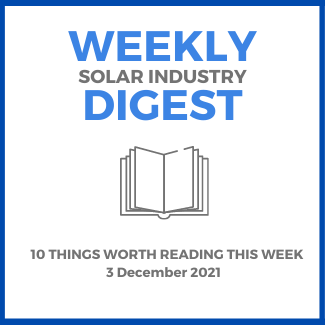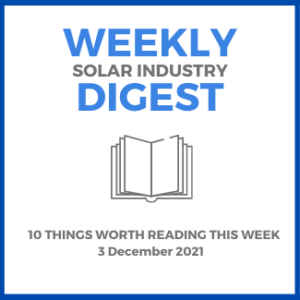Amazon has procured 18 new renewable projects in the US and Europe, a total of 5.6 GW in combined capacity, 8 of which are American solar projects. This, plus their recent investment in 274 utility-scale renewables projects globally, brings the company to more than 12 GW and 33,700 GWh and closer to their new goal of 100% of biz operations using renewable energy by 2025.
Aurora has another useful roundup: latest incentives. They talk about the benefits to installers and customers of the 26% ITC extension till 2023, using SRECs in your sales conversations, 7 California solar incentives, and a big picture overview of what is out there around financing incentives.
One substantive result from Glasgow is the growth of public-private initiatives around climate solutions. BlackRock’s Climate Finance Partnership is a one such program, a public-private fund targeting investments globally that aren’t part of the OECD. Apparently “each dollar of catalytic funding from public development banks and philanthropy has attracted $4 of institutional capital.”
Though energy storage can be an economic stretch for many res and commercial customers with stand-alone systems, community solar’s ability to pool resources and the energy demand of multiple customs can make the economics of storage work. New tech, shortened interconnection waits, and legislation for storage valuation is needed to move it forward.
Energy storage is still a bit of an economic stretch for most residential and many commercial customers as stand-alone projects. But community solar’s ability to pool the solar resources and energy demand of dozens of such customers, spread over an entire county or two, makes storage far more attractive.
Bill Nussey discusses his latest book on the history and future of the energy grid and the local energy revolution in this Suncast podcast episode. He discusses how his research came about, what the next wave of infrastructure and investment will look like and why small scale, local energy systems are deeply disruptive.
A new IEA report says that US renewable capacity is set to go up 65% in then next 5 years, adding more than 200 GW of what will mostly be solar. This forecast is a 35% increase over previous estimates due to state and federal incentives and corporate procurement. However, meeting U.S. offshore wind targets will need additional federal policy intervention.
Building solar on closed landfills is an untapped opportunity – it can be a market for developers and help create energy equity given that landfills tend to be in economically depressed areas. Roadblocks include more engineering and regulatory expenses and complications and a lack of supportive city or state policies to make the economics worthwhile.
OpenSolar, a software design company dedicated to streamlining the solar sales process, now offers integration with IronRidge‘s solar racking and mounting products on its website. Their platform allows installers to automatically calculate the cost of IronRidge racking and mounting components for each design – and it includes educational resources on IronRidge products.
David Dunlap of BayWa r.e. sounds off on supply chain issues in this interview. Some insights include the idea that it will take another 6-9 months to ease up the massive port congestion and truck driver shortages, the fact that BayWa r.e. is bolstering end-to-end processes that support a great customer experience during the constraints, and the notion that delivering bad news is a necessary skill.


